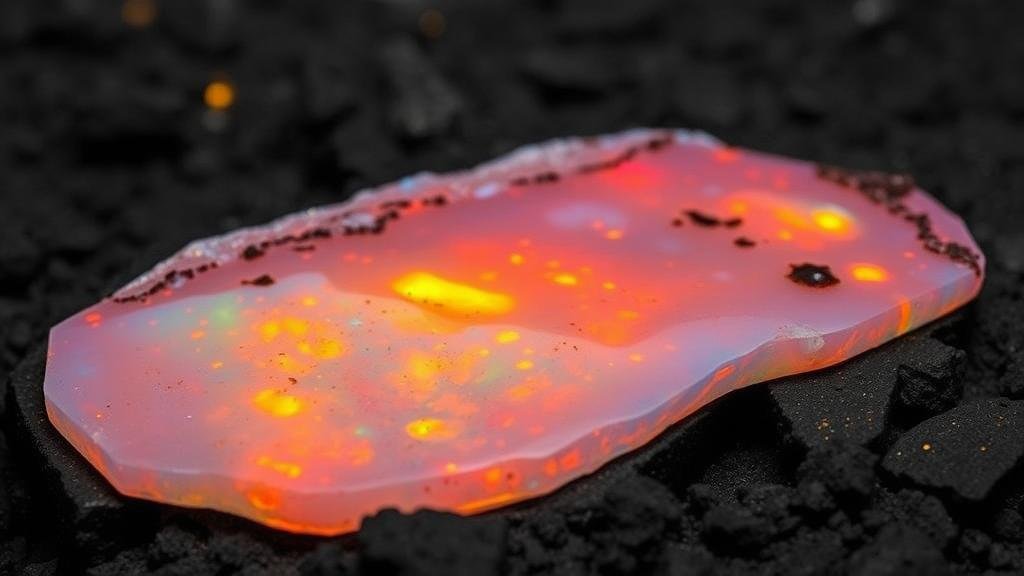Discovering rare fire opals in Mexico’s volcanic fields, renowned for their fiery hues.
Discovering Rare Fire Opals in Mexico’s Volcanic Fields
Renowned for their astonishing colors and captivating natural beauty, fire opals are a gemstone that has bewitched mineral collectors and rockhounds alike. Originating primarily from Mexico’s volcanic fields, these gems are celebrated for their vibrant hues and unique characteristics. This article dives into the intricate world of fire opals, emphasizing their geological context, collection techniques, and the practicalities of sourcing these precious stones.
The Geological Context of Fire Opals
Fire opals are a variety of opal that displays a striking play of color, often showcasing fiery orange, red, and yellow tones, reminiscent of molten lava. e gemstones are formed in volcanic regions, primarily found in the Mexican states of Querétaro, Puebla, and Oaxaca. The opals occur within silica-rich volcanic ash deposits where hot volcanic gases and minerals interact with silica-rich components.
For collectors aiming to understand the geological environment of fire opals, a few key measurements and aspects are essential:
- Composition: Fire opals primarily consist of silicon dioxide (SiO2), and usually contain up to 20% water.
- Hardness: On the Mohs scale, fire opals typically range between 5.5 to 6.5, making them relatively durable yet requiring care.
Key Locations for Fire Opal Mining
The Mexican volcanic fields are replete with renowned sites for discovering fire opals. Notable locations include:
- Huitzilac, Morelos: A region notable for its clear and fiery specimens.
- San Luis PotosÃ: Known for the production of larger cabochon-quality stones with exceptional color saturation.
- Oaxaca: Contains varied hues and is popular among both professional miners and amateur collectors.
Collecting Techniques and Tips
For aspiring rockhounds, effectively searching for fire opals demands both knowledge and skill. Here are practical techniques to enhance your collecting experience:
- Research: Familiarize yourself with geological maps and mining locations where opal deposits are located.
- Timings: The best time to search is after heavy rain when erosion may expose new deposits.
- Tools: Equip yourself with tools such as a pickaxe, shovel, and small hand tools to excavate carefully.
Protecting Your Collection
Once you have successfully acquired fire opals, the next step is protecting and preserving them. These gemstones are sensitive to environmental conditions and require special care:
- Storage: Store opals in a soft cloth or padded container to prevent scratches and damage.
- Humidity: Maintain a consistent level of humidity in your storage environment, as fluctuations can affect the water content in the opal.
Real-World Applications of Fire Opal
Fire opals are not only appreciated in the mineral collection community but are also valued in gemstone jewelry. Their vibrant colors make them a desirable choice for rings, necklaces, and bracelets. In recent years, they have become increasingly popular in artisanal jewelry making due to their unique aesthetic appeal. Plus, their historical significance in indigenous cultures enhances their value and desirability, making them a multifaceted investment for collectors.
Conclusion: Taking Action as a Collector
Discovering rare fire opals in Mexico’s volcanic fields is an exhilarating pursuit for rockhounds and mineral collectors. By understanding the geological context, employing effective collecting techniques, and safeguarding your finds, you can enhance your collection while appreciating the beauty of these remarkable gems. Now is the time to embark on your journey into this fiery realm of nature’s artistry.



